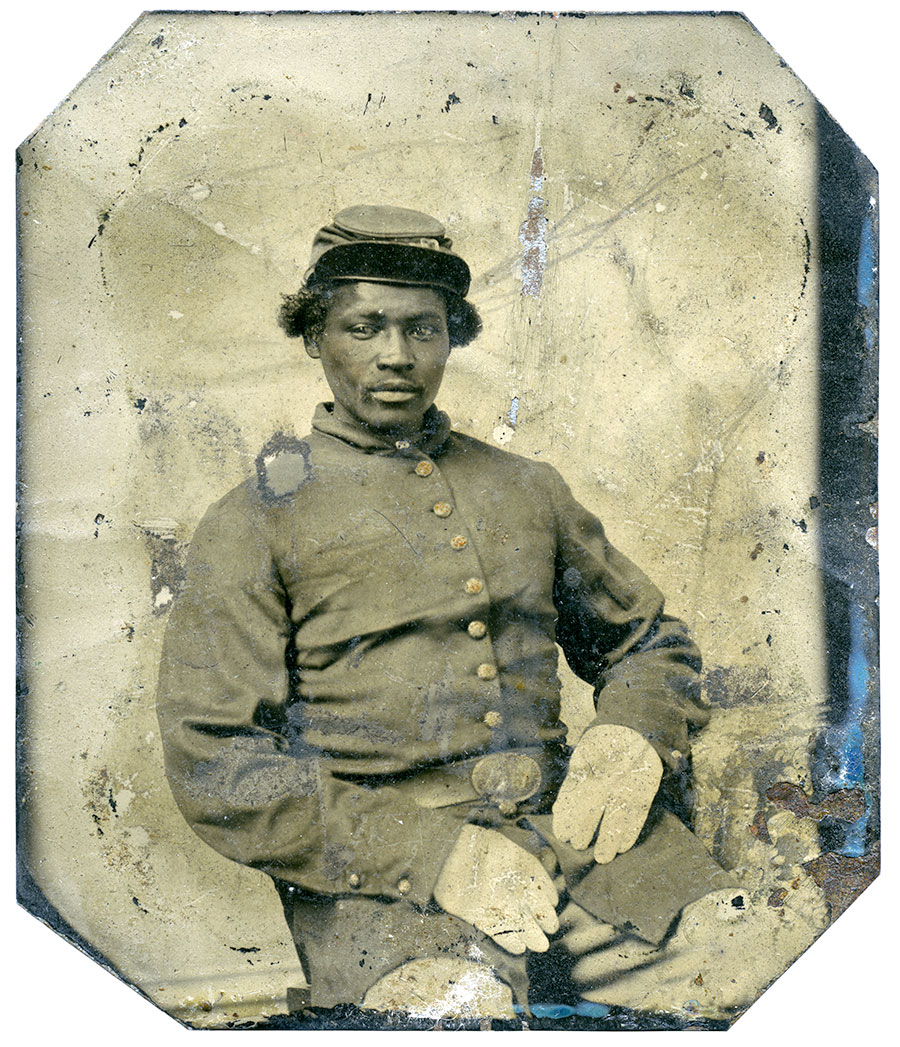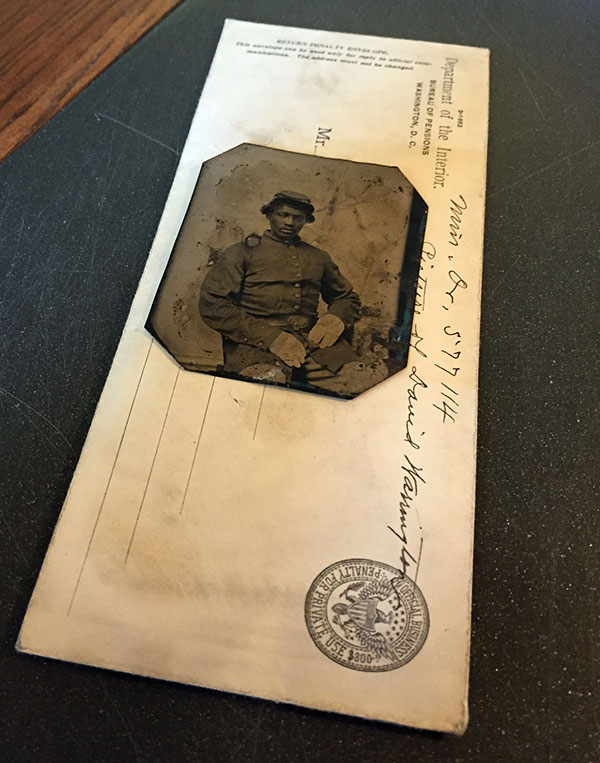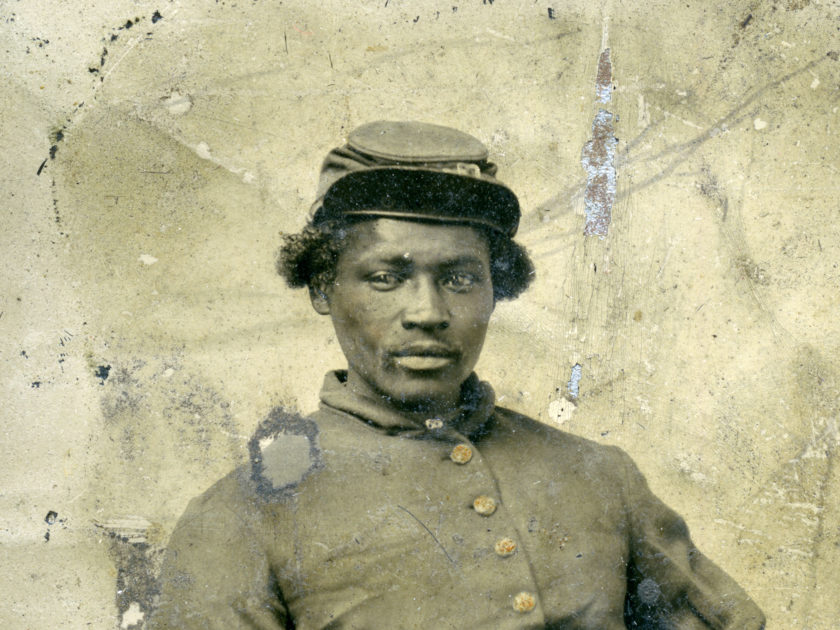By Andrew L. Slap
Dave Warrington might never have joined the Union army. But the Missouri-born farmer, 28, agreed to don a blue uniform after another man who had been drafted paid him to be his substitute.
In late October 1864, Warrington enlisted at Mount Sterling, Ill., just across the Mississippi River from Missouri. His brother, James, who was also a substitute, joined him.

Warrington posed for this tintype soon after—and he could never have guessed that it would some day play an important part in his family’s future.
The Warrington brothers were sent to Springfield, the Illinois capital, and then south to Memphis, Tenn., where they joined different companies of the 3rd U.S. Colored Heavy Artillery. The regiment composed part of the garrison that defended the important Mississippi River city.
Warrington’s service record incorrectly listed him as David Washington, a seemingly innocuous clerical error that the illiterate soldier may never have noticed. Warrington mustered out of the army after his term of service expired in late October 1865. His brother mustered out at the same time. They settled down in Monroe County, Ill., a rural area south of St. Louis. The region was described by one person as a “wilderness,” where “a few men owned that good land and had negroes and poor whites in shacks down there to work at taking off the heavy timber.”
It was not always hard work for Warrington. He met Charlotte “Lottie” Grimes, a young woman who may have been the sister of Frank Grimes, a soldier who had served with Warrington in the army. After a few years of courtship, David married 18-year-old Lottie on July 25, 1872. Lottie gave birth to a daughter, named Sylvia, 10 months later. Around 1878, the couple had a second daughter, Diana, who, according to her sister, “was always a little weak thing.” By all accounts the family was happy. A neighbor recalled, “I well remember Dave going long distances home at night when he and I were feeding threshing machine and saying he had a little baby at home and had to go and I know he was referring to this Diana.” Another neighbor gave a similar account. “He was foolish about Charlotte and the two children and would walk home four or five miles from his work just to be with his said wife and said children when he did not have to.”
Tragedy struck the young family in 1882, when Lottie died of pneumonia at age 28. Warrington’s sister, Mary, moved in and became a mother to his daughters. A neighbor recalled that “I used to see Dave out on the lake bank fishing and these two children, Sylvia and Dianna with him, and their mother Charlotte was dead and gone and then for he took them along to get them out of the way of his sister Mary.”
Seven months after his wife died however, Warrington became ill with pulmonary tuberculosis. He succumbed to the infection in the spring of 1883.
Warrington’s brother-in-law, Frank Grimes, stepped in and took his two orphaned nieces to live with him in St. Louis. The younger child, Diana, who was about four years old when her father died, had no memories of her parents. “The first I can remember I was living here in St. Louis in the house of my Uncle Frank Grimes,” she recalled.
To provide for the girls, Grimes turned to the Pension Bureau for assistance. In 1893, he filed for a pension on behalf of Diana, who was then about 15 years old and eligible for minor’s benefits for her late father’s military service. Her older sister, Sylvia, who was about 20, was too old to collect.
Unfortunately, the misspelling of Warrington’s last name almost three decades earlier now had huge consequences. The pension application listed the soldier’s name as David Warrington, while the service records only showed a David Washington. Despite receiving periodic correspondence from relatives trying to clear up the confusion, the government did not award her the pension. Diana probably needed the support: A government employee commented that she “has been very shallow mentally from birth and she is a weak pattern physically.” Eventually, in 1923, Diana wrote pension officials about the application filed by her uncle 30 years earlier.

Special examiners in the pension office investigated the claim, and interviewed people from Illinois to California. One key piece of evidence was this photograph of Warrington. A cousin explained how the image wound up in the hands of Diana’s older sister, Sylvia Warrington Mitchell. “I gave to Sylvia Mitchell, David Warrington’s daughter, a tintype picture of a man which my mother always taught me is the likeness of her brother David Warrington and the picture resembles him.”
The special examiners took the photograph with them on their interviews in an attempt to corroborate that David Warrington and David Washington were the same person. Upon seeing the photograph, a former neighbor declared, “I can easily tell you whose likeness that picture is; it is the picture of a man named Dave Warrington I used to know in Monroe County, Ill. I did not have to have you or anyone else tell me whose picture that is.” Diana Warrington not only received the pension, but the Pension Office also backdated it to 1894, when she should have first received payment.
Warrington had posthumously supported his little girl with a photograph he had taken almost 60 years earlier. Regrettably, this photograph was the only image Diana had of her father. She told a special examiner, “He must have been a soldier as I have here a tin type of a man in soldier clothes which my sister says is the likeness of our father. I will lend this picture but wish it returned to me.”
The unreturned picture remained buried in the pension for almost a century. It is still in the possession of the National Archives.
Andrew L. Slap is professor of history at East Tennessee State University and is the author or editor of several books about the Civil War.
SPREAD THE WORD: We encourage you to share this story on social media and elsewhere to educate and raise awareness. If you wish to use any image on this page for another purpose, please request permission.
LEARN MORE about Military Images, America’s only magazine dedicated to showcasing, interpreting and preserving Civil War portrait photography.
VISIT OUR STORE to subscribe, renew a subscription, and more.

